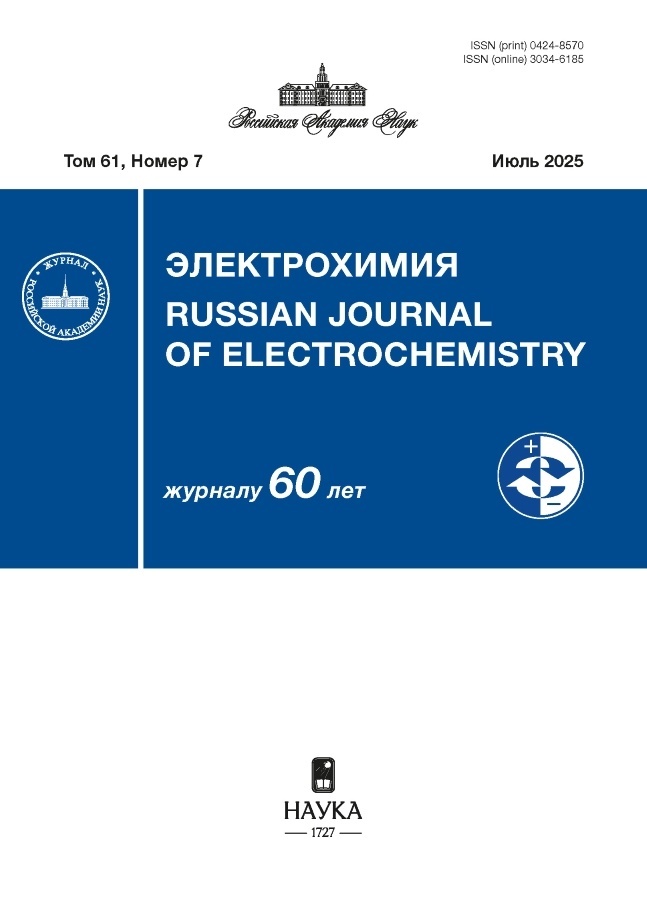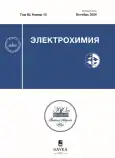Role of nonlocal electrostatic effects in the stabilization of monovalent cations in an aqueous cavity surrounded by a weakly polar environment
- Authors: Rubashkin A.A.1, Vigont V.A.1, Vorotyntsev M.A.2
-
Affiliations:
- Institute of Cytology RAS
- Institute of Physical Chemistry and Electrochemistry named after A.N. Frumkin RAS
- Issue: Vol 60, No 10 (2024): Спецвыпуск “Электрохимия-2023”, часть 1
- Pages: 722-744
- Section: Articles by participants of the All-Russian Conference “Electrochemistry-2023” (Moscow, October 23–26, 2023)
- URL: https://gynecology.orscience.ru/0424-8570/article/view/677618
- DOI: https://doi.org/10.31857/S0424857024100066
- EDN: https://elibrary.ru/OHHFNE
- ID: 677618
Cite item
Abstract
We developed earlier (Russ. J. Electrochem., 2018, vol. 54, p. 879), a new nonlocal electrostatic (NE) method for calculating electric field distributions in systems where there are spatially limited regions filled with polar media with nonlocal dielectric properties. This method was used for NE analysis of the stabilization of a monovalent cation in a spherical cavity filled with water and surrounded by a local dielectric. For one- and three-mode models of the dielectric function, NE formulas were obtained for the field distribution inside such a cavity, provided that the ion is located at its center. NE relations have been derived for the change in cation solvation energy ΔW during its transition from solution to the center of such a cavity. It is shown that when the correlation length of water in the cavity decreases compared to the solution (at the same values of the dielectric constant of water in the cavity and in the volume of the solution), the amount of work to transfer an ion from the solution into the cavity (–ΔW) decreases significantly compared to the calculation using the local theory used in the work (B. Roux, R. MacKinnon, Science, 1999, vol. 285, p. 100).
Full Text
About the authors
A. A. Rubashkin
Institute of Cytology RAS
Author for correspondence.
Email: andrey.rubashkin@gmail.com
Russian Federation, St. Petersburg
V. A. Vigont
Institute of Cytology RAS
Email: andrey.rubashkin@gmail.com
Russian Federation, St. Petersburg
M. A. Vorotyntsev
Institute of Physical Chemistry and Electrochemistry named after A.N. Frumkin RAS
Email: mivo2010@yandex.com
Russian Federation, Moscow
References
- Hille, B. Ion Channels of Excitable Membrane, Sunderland, MA: Sinauer, 3rd Ed., 2001. 814 p.
- Roux, B. and MacKinnon, R., The cavity and pore helices in the KcsA K+ Channel: Electrostatic stabilization of monovalent cations, Science, 1999, vol. 285, p. 100.
- Doyle, D.A., Cabral, J.M., Pfuetzner, R.A., Kuo A., Gulbis, J.M., Cohen, S.L., Chait, B.T., and MacKinnon, R., The structure of the potassium channel: molecular basis of K+ conduction and selectivity, Science, 1998, vol. 280, p. 69.
- Bichet, D., Grabe, M., Jan, Y.N., and Jan, L.Y., Electrostatic interactions in the channel cavity as an important determinant of potassium channel selectivity, PNAS, 2006, vol. 103, p. 14355.
- Zhou, Y. and MacKinnon, R., Ion binding affinity in the cavity of the KcsA potassium channel, Biochemistry, 2004, vol. 43, p. 4978.
- Kariev, A. and Green, M.E., Quantum calculations on water in the KcsA channel cavity with permeant and nonpermeant ions, Biochim. Biophys. Acta – Biomembranes, 2009, vol. 1788, p. 1188.
- Yao, Z., Qiao, B., and de la Cruz, M.O., Potassium ions in the cavity of a KcsA channel model, Phys. Rev. E, 2013, vol. 88, p. 062712.
- Song, Z., Cao, X., Horng, T.-L., and Huang, H., Selectivity of the KcsA potassium channel: Analysis and computation, Phys. Rev. E, 2019, vol. 100, p. 022406.
- Kariev, A.M. and Green, M.E., The pore of the KcsA channel, including the entire cavity up to the selectivity filter, participates in selectivity, rectification, and ion transport, Biophys. J., 2023, vol. 122, SUPPLEMENT 1, p. 525A.
- Israelachvili, J.N. Intermolecular and Surface Forces, Academic Press, 3rd Ed., 2011. 674 p.
- Israelachvili, J.N. and Pashley, R.M., Molecular layering of water at surfaces and origin of repulsive hydration forces, Nature, 1983, vol. 306, p. 249.
- Toney, M., Howard, J., Richer, J., Borges, G.L., Gordon, J., Melroy, O., Wiesler, D., Yee, D., and Sorensen, L., Voltage-Dependent Ordering of Water Molecules at an Electrode-Electrolyte Interface, Nature, 1994, vol. 368, p. 444.
- Velasco-Velez, J.-J., Wu, C.H., Pascal, T.A., Wan, L.F., Guo, J., Prendergast, D., and Salmeron, M., The structure of interfacial water on gold electrodes studied by x-ray absorption spectroscopy, Science, 2014, vol. 346, p. 831.
- Fumagalli, L., Esfandiar, A., Fabregas, R., Hu, S., Ares, P., Janardanan, A., Yang, Q., Radha, B., Taniguchi, T., Watanabe, K., Gomila, G., Novoselov, K.S., and Geim, A. K., Anomalously low dielectric constant of confined water, Science, 2018, vol. 360, p. 1339.
- Рубашкин, А.А., Исерович П. Новый подход к селективности ионных каналов. Нелокально электростатическое расмотрение. Докл. Акад. наук. 2007. Т. 417. С. 121. [Rubashkin, A.A. and Iserovich, P., A new approach to the selectivity of ion channels: Nonlocal electrostatic consideration, Dokl. Biochem. and Biophys., 2007, vol. 417, p. 302.]
- Bardhan, J.P., Nonlocal continuum electrostatic theory predicts surprisingly small energetic penalties for charge burial in proteins, J. Chem. Phys., 2011, vol. 135, p. 104113–1.
- Рубашкин, А.А. Роль пространственной дисперсии диэлектрической проницаемости сферической водной полости в уменьшении свободной энергии переноса иона в полость. Электрохимия. 2014. Т. 50. С. 1212. [Rubashkin, A.A., The role of spatial dispersion of the dielectric constant of spherical water cavity in the lowering of the free energy of ion transfer to the cavity, Russ. J. Electrochem., 2014, vol. 50, p. 1090.]
- Корнышев, А.А., Цицуашвили, Г.И., Ярощук, А.Э. Эффект структуры полярного растворителя в теории диэлектрического исключения ионов из пор полимерных мембран. Постановка задачи. Расчет потенциала. Электрохимия. 1989. Т. 25. С. 1027. [Kornyshev, A.A., Tsitsuashvili, G.I., and Yaroschuk, A.E., The effect of polar solvent structure in the theory of dielectric exclusion of ions from polymermembrane pores. Setting of the problem. Calculation of potential, Sov. Electrochem., 1989, vol 25, p. 923.]
- Корнышев, А.А., Цицуашвили, Г.И., Ярощук, А.Э. Эффект структуры полярного растворителя в теории диэлектрического исключения ионов из пор полимерных мембран. Расчет свободной энергии переноса заряда из объема растворителя в пору. Электрохимия. 1989. Т. 25. С. 1037. [Kornyshev, A.A., Tsitsuashvili, G.I., and Yaroschuk, A.E., The effect of polar solvent structure in the theory of dielectric exclusion of ions from polymermembrane pores. Calculation of free energy of charge transfer from the solvent into a pore, Sov. Electrochem., 1989, vol 25, p. 932.]
- Kornyshev, A.A., Nonlocal screening of ions in a structurized polar liquid – new aspects of solvent description in electrolyte theory, Electrochim. Acta, 1981, vol. 26, p. 1.
- Воротынцев, М.А., Корнышев, А.А., Электростатика сред с пространственной дисперсией. М.: Наука., 1993. 240 с. [Vorotyntsev, M. A. and Kornyshev, A.A., Electrostatics of Media with Spatial Dispersion (in Russian), Moscow: Nauka, 1993. 240 p.]
- Kornyshev, A.A., Rubinshtein, A.I., and Vorotyntsev, M.A., Model nonlocal electrostatics: 1, J. Phys. C: Solid State Phys., 1978, vol. 11, p. 3307.
- Vorotyntsev, M.A., Model nonlocal electrostatics: II. Spherical interface, J. Phys. C: Solid State Phys., 1978, vol. 11, p. 3323.
- Hildebrandt, A., Blossey, R., Rjasanow, S., Kohlbacher, O., and Lenhof, H.-P., Novel Formulation of Nonlocal Electrostatics, Phys. Rev. Lett., 2004, vol. 93, p. 108104–1.
- Rubinstein, A. and Sherman, S., Influence of the Solvent Structure on the Electrostatic Interactions in Proteins, Biophys. J., 2004, vol. 87, p. 1544.
- Rubinstein, A.I., Sabirianov, R.F., and Namavar, F., Effects of the dielectric properties of the ceramic-solvent interface on the binding of proteins to oxide ceramics: a non-local electrostatic approach, Nanotechnology, 2016, vol. 27, p. 415703.
- Rubinstein, A., Sabirianov, R.F., Mei, W.N., Namavar, F., and Khoynezhad, A., Effect of the ordered interfacial water layer in protein complex formation: A nonlocal electrostatic approach, Phys. Rev. E, 2010, vol. 82, p. 021915.
- Paillusson, F. and Blossey, R., Slits, plates, and Poisson-Boltzmann theory in a local formulation of nonlocal electrostatics, Phys. Rev. E, 2010, vol. 82, p. 052501–1.
- Kornyshev, A.A. and Sutmann, G., The shape of the nonlocal dielectric function of polar liquids and the implications for thermodynamic properties of electrolytes: a comparative study, J. Chem. Phys., 1996, vol. 104, p. 1524.
- Kornyshev, A.A., Leikin, S., and Sutmann, G., “Overscreening” in a polar liquid as a result of coupling between polarization and density fluctuations, Electrochim. Acta, 1997, vol. 42, p. 849.
- Bopp, P.A., Kornyshev, A.A., and Sutmann, G., Static nonlocal dielectric function of liquid water, Phys. Rev. Lett., 1996, vol. 76, p. 1280.
- Fedorov, M.V. and Kornyshev, A.A., Unravelling the solvent response to neutral and charged solutes, Mol. Phys., 2007, vol. 105, p. 1.
- Holub, K. and Kornyshev, A.A., Comment on the solvent structure in thermodynamics of electrolytes: anomalous behaviour of activity coefficients at low concentrations, J. Electroanal. Chem., 1982, vol. 142, p. 57.
- Kornyshev, A.A., Non-local dielectric response of a polar-solvent and Debye screening in ionic solution, J. Chem. Soc. Faraday Trans.II, 1983, vol. 79, p. 651.
- Kornyshev, A.A., Nonlocal electrostatics of solvation, in: R.R. Dogonadze, E. Kalman, A.A. Kornyshev, J. Ulstrup (Eds.), The Chemical Physics of Solvation. Amsterdam: Elsevier Science Ltd, 1985, p. 268.
- Basilevsky, M.V. and Parsons, D.F., An advanced continuum medium model for treating solvation effects: nonlocal electrostatics with a cavity, an advanced continuum medium model for treating solvation effects: nonlocal electrostatics with a cavity, J. Chem. Phys., 1996, vol. 105, p. 3734.
- Basilevsky, M.V. and Parsons, D.F. Nonlocal continuum solvation model with exponential susceptibility kernels, J. Chem. Phys., 1998, vol. 108, p. 9107.
- Воротынцев, М.А., Рубашкин, А.А., Антипов, А.Е. Новый подход в теории ограниченных в пространстве нелокальных диэлектрических сред. Электрохимия. 2018. Т. 54. № 10 ПРИЛОЖЕНИЕ. С. S54–S61. [Vorotyntsev, M.A., Rubashkin, A.A., and Antipov, A.E., A new approach in the theory of space-confined nonlocal dielectric media, Russ. J. Electrochem., 2018, vol. 54, p. 879.]
- Vorotyntsev, M.A. and Rubashkin, A.A., Uniformity ansatz for inverse dielectric function of spatially restricted nonlocal polar medium as a novel approach for calculation of electric characteristics of ion–solvent system, Chem. Phys., 2019, vol. 521, p. 14.
- Rubashkin, A.A., Iserovich, P., and Vorotyntsev, M.A., Physical origin of Na+/Cl- selectivity of tight junctions between epithelial cells. Nonlocal electrostatic approach, J. Mol. Liq., 2020, 317, p. 113884–1.
- Dogonadze, R.R. and Kornyshev, A.A., Polar solvent structure in the theory of ionic salvation, J. Chem. Soc. Faraday Trans. II, 1974, vol. 70, p. 1121.
- Kornyshev, A.A. and Volkov, A.G., On the evaluation of standard Gibbs energies of ion transfer between 2 solvents, J. Electroanal. Chem., 1984, vol. 180, p. 363.
- Зубарев, Д.Н. Неравновесная статистическая термодинамика. М.: Наука, 1971. 416 с. [Zubarev, D.N., Non-Equilibrium Statistical Thermodynamics (in Russian), Moscow: Nauka, 1971. 416 p.]
Supplementary files













